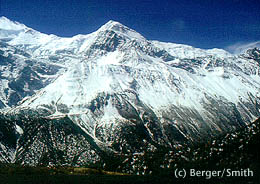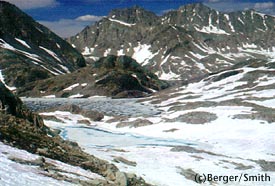We all know that tourism can have benefits for local cultures, especially if the economic infrastructure is set up in a way that provides good jobs (and training for even better jobs) and sources products locally. But there is a careful balance to be maintained: Too many tourists can shift the balance and cause harm, as well as good. Overdependence on tourism may threaten traditional ways of making a living, leaving locals vulnerable to global economics that affect tourism in their area. Well-meaning gifts can encourage children to turn to begging rather than education. Cultural conflict, economic disparity, and pollution can follow in the footsteps of well-shod tourists.
Treks on Nepal’s famous routes such as the Mt. Everest Trek or the Annapurna Circuit are on the life-list of many adventure travelers. That means crowds. Both the fragile alpine environment and subsistence culture are vulnerable to damage from tourism.
Environmental Issues for Trekkers in Nepal
 |
| High Country is Harsh and Fragile |
The high altitude and alpine environment of most of Nepal’s trekking areas, such as the popular Annapurna Circuit and Everest Trek, makes these regions extremely vulnerable to pollution and overuse. Surprisingly, guided groups may actually have less impact than unguided independent trekkers, especially if the groups are run in an environmentally responsible manner.
Take cooking fuel. It’s a seemingly small issue, but it has big ramifications. Environmentally responsible groups bring in their own cooking fuel, rather than relying on locally sourced (and rare) wood. In contrast, food prepared for independent trekkers is often cooked on wood-burning stoves, which contributes to deforestation — a major problem in fragile alpine areas. Cut-rate tours arranged in the back-alley outfitters of Kathmandu may not adhere to the same environmental standards as groups run by established tour agencies. When arranging a trek, ask about environmental issues.
Waste is another problem. Some popular sections of trails are strewn with waste, including toilet paper. The same leave-no-trace rules you follow at home should be followed on Nepal’s trails: Pack out all batteries and plastic waste, and as much as possible, all other trash. In the dry cold air of high altitudes, it takes a long time for anything to decompose, and this includes those pink “flowers” of TP. Dispose of toilet paper by burning it, disposing of it in outhouses when they are available, or leaving it in a toilet refilled with earth – anything to be sure it won’t resurface as litter.
More Minimum Impact Tips
 |
| Annapurna Sanctuary |
- If camping with a group, share a toilet pit, and fill it in so no trace remains after use. It should be at least 100 feet from a stream or river.
- There is no way to dispose of or recycle plastic water bottles in the remote villages. Instead of buying bottled water, use a purifier.
- The widely available local staple food, dal bhat, is a combination of lentils and rice (and sometimes vegetables). It places fewer burdens on local villagers to produce this meal, as the ingredients are available locally.
- Wash with bio-degradable soaps — again, not near a stream or river.
Cultural Issues for Trekkers in Nepal
For us tourists, the chance to interact with another culture is a precious one, and it can be hard to see that we can be doing harm when we visit a village, give presents to children, and photograph sacred sites. But too many tourists, even well-meaning ones, can place stress on indigenous and subsistence cultures. A society that has functioned on its own for centuries can find itself suddenly dependent on tourist dollars. Western values may erode cultural norms. To lessen impact:
- Nepal’s’ culture is very religious, combining aspects of Buddhism and Hinduism. Always walk to the right side of the many mani walls (walls with carvings found alongside the trails), or counterclockwise around stupas and monuments. This ensures that no matter which way you go, when you return, you will make a full circle.
- Resist the urge to give gifts to begging children. Begging undermines a culture. Those who wish to help can give a package of pens to a local school, share some food, or make a donation through one of the many aid agencies in Kathmandu. Himalayan Rescue Association is a worthy cause, as it provides medical aid to rural Nepali villagers and mounts an altitude sickness prevention education program for trekkers.
- Hire porters. This is at traditional way of trekking in Nepal, and is a way of contributing to the economy without giving alms or undermining the culture: Trekkers pay for work performed. The cost is minimal, and the positive impact is huge.
- Ask guides about the appropriate behavior at shrines and religious sites.
- Ask people before photographing them; they aren’t objects.
By following these simple precepts, visitors can help ensure they are following the Leave-no-Trace edict of taking only pictures, leaving only footprints.

